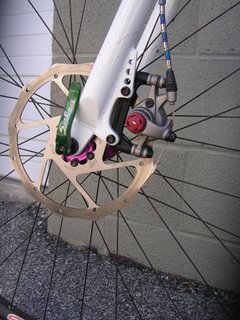
I have run across this question on how to best set up a mechanical disc brake for a bicycle enough that I thought a post on it was in order.
There are several choices for mechanical disc brakes out there, but the most common to the serious off roader is going to be the Avid BB-7, which is pictured here. That being the case, I will say that my specific tips will benefit any user of any type of mechanical disc brake.
First of all, it's not so much how you set up the caliper, although that is critical, of course. However; you can have a perfectly installed caliper, rotor, and brake lever and still have a crappy brake that's not much better than a linear pull brake and it'll be a heck of alot heavier than a linear pull brake to boot.
The trick to getting the most out of your mechanical disc brake is in the cable, housing for that cable, and your choice of brake lever. Without careful consideration for each of these component choices, you are going to have a sub-standard set up on your brakes.
Brake Lever: While it's true that any linear pull compatible brake lever will work with mechanical disc brakes, not all levers are created equal. Many linear pull levers are sloppy, flexy, and do not pull as much cable as some other higher end levers. If you are using a lever that isn't solid and flex free, you are losing braking power! I recommend using a quality linear pull lever like an Avid SD-1 or better. Paul Love Levers are also really good. A flex free lever with little to no pivot slop is imperative for getting the most out of a mechanical disc brake.
Cable: Ahh! The lowly mountain bike brake cable. What possibly could you want better than that? Well, another thing that kills mechanical disc brake power and especially feel is a dry, dirty, or rusted cable. One of the best things you can do to improve your existing mechanical disc brake is to get that plain old cable out and replace it with a Teflon coated type cable. These are available from several manufacturers. They are more slippery in the housing, they resist corrosion, and are relatively cheap.
Cable Housing: Here's the big one. If you do not do anything else, do this! First, go out and squeeze the brake lever of a linear brake equipped bike. Watch the cable housing. (This works best if you squeeze the front brake lever on a linear brake equpped bike) With pressure applied you can see the housing moving. Big deal, you say? Well, that's brake power that you are loosing, my friend. That's especially bad on a mechanical disc brake system. You can get rid of this by using a compressionless cable housing like my Nokon system in the picture above. (Look for the silver/blue/silver housing) Compressionless housings resist or eliminate flex which in turn makes your mechanical disc brake much more powerfull. This is an expensive upgrade, but well worth the effort if you desire to have the best mechanical brake set up possible, and it's still cheaper than alot of mid to high end hydro brake set ups, even if you include the costs of all of your bits and pieces.
So, that's it. You can have a mechanical brake set up that rivals any hydro brake and have yours be leak free, field serviceable, and never have to bleed the system. Joy! And, if you use a sealed cable system like Nokon's, you won't even have dirt or lube problems to deal with. If you have a mechanical disc brake set, and you haven't tried any of these things, you haven't reached the potential of your brakes yet. Not even close!

No comments:
Post a Comment